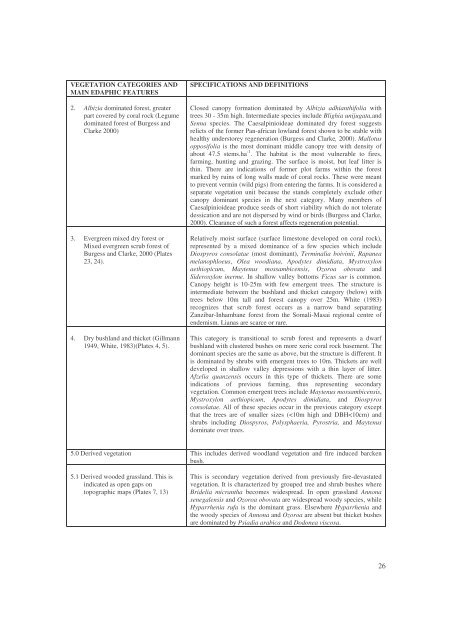Jozani biodiversity inventory report 2002 - Coastal Forests of Kenya ...
Jozani biodiversity inventory report 2002 - Coastal Forests of Kenya ...
Jozani biodiversity inventory report 2002 - Coastal Forests of Kenya ...
You also want an ePaper? Increase the reach of your titles
YUMPU automatically turns print PDFs into web optimized ePapers that Google loves.
VEGETATION CATEGORIES AND<br />
MAIN EDAPHIC FEATURES<br />
2. Albizia dominated forest, greater<br />
part covered by coral rock (Legume<br />
dominated forest <strong>of</strong> Burgess and<br />
Clarke 2000)<br />
3. Evergreen mixed dry forest or<br />
Mixed evergreen scrub forest <strong>of</strong><br />
Burgess and Clarke, 2000 (Plates<br />
23, 24).<br />
4. Dry bushland and thicket (Gillmann<br />
1949, White, 1983)(Plates 4, 5).<br />
SPECIFICATIONS AND DEFINITIONS<br />
Closed canopy formation dominated by Albizia adhianthifolia with<br />
trees 30 - 35m high. Intermediate species include Blighia unijugata,and<br />
Senna species. The Caesalpinioideae dominated dry forest suggests<br />
relicts <strong>of</strong> the former Pan-african lowland forest shown to be stable with<br />
healthy understorey regeneration (Burgess and Clarke, 2000). Mallotus<br />
opposifolia is the most dominant middle canopy tree with density <strong>of</strong><br />
about 47.5 stems.ha -1 . The habitat is the most vulnerable to fires,<br />
farming, hunting and grazing. The surface is moist, but leaf litter is<br />
thin. There are indications <strong>of</strong> former plot farms within the forest<br />
marked by ruins <strong>of</strong> long walls made <strong>of</strong> coral rocks. These were meant<br />
to prevent vermin (wild pigs) from entering the farms. It is considered a<br />
separate vegetation unit because the stands completely exclude other<br />
canopy dominant species in the next category. Many members <strong>of</strong><br />
Caesalpinioideae produce seeds <strong>of</strong> short viability which do not tolerate<br />
dessication and are not dispersed by wind or birds (Burgess and Clarke,<br />
2000). Clearance <strong>of</strong> such a forest affects regeneration potential.<br />
Relatively moist surface (surface limestone developed on coral rock),<br />
represented by a mixed dominance <strong>of</strong> a few species which include<br />
Diospyros consolatae (most dominant), Terminalia boivinii, Rapanea<br />
melanophloeus, Olea woodiana, Apodytes dimidiata, Mystroxylon<br />
aethiopicum, Maytenus mossambicensis, Ozoroa obovata and<br />
Sideroxylon inerme. In shallow valley bottoms Ficus sur is common.<br />
Canopy height is 10-25m with few emergent trees. The structure is<br />
intermediate between the bushland and thicket category (below) with<br />
trees below 10m tall and forest canopy over 25m. White (1983)<br />
recognizes that scrub forest occurs as a narrow band separating<br />
Zanzibar-Inhambane forest from the Somali-Masai regional centre <strong>of</strong><br />
endemism. Lianas are scarce or rare.<br />
This category is transitional to scrub forest and represents a dwarf<br />
bushland with clustered bushes on more xeric coral rock basement. The<br />
dominant species are the same as above, but the structure is different. It<br />
is dominated by shrubs with emergent trees to 10m. Thickets are well<br />
developed in shallow valley depressions with a thin layer <strong>of</strong> litter.<br />
Afzelia quanzensis occurs in this type <strong>of</strong> thickets. There are some<br />
indications <strong>of</strong> previous farming, thus representing secondary<br />
vegetation. Common emergent trees include Maytenus mossambicensis,<br />
Mystroxylon aethiopicum, Apodytes dimidiata, and Diospyros<br />
consolatae. All <strong>of</strong> these species occur in the previous category except<br />
that the trees are <strong>of</strong> smaller sizes (
















